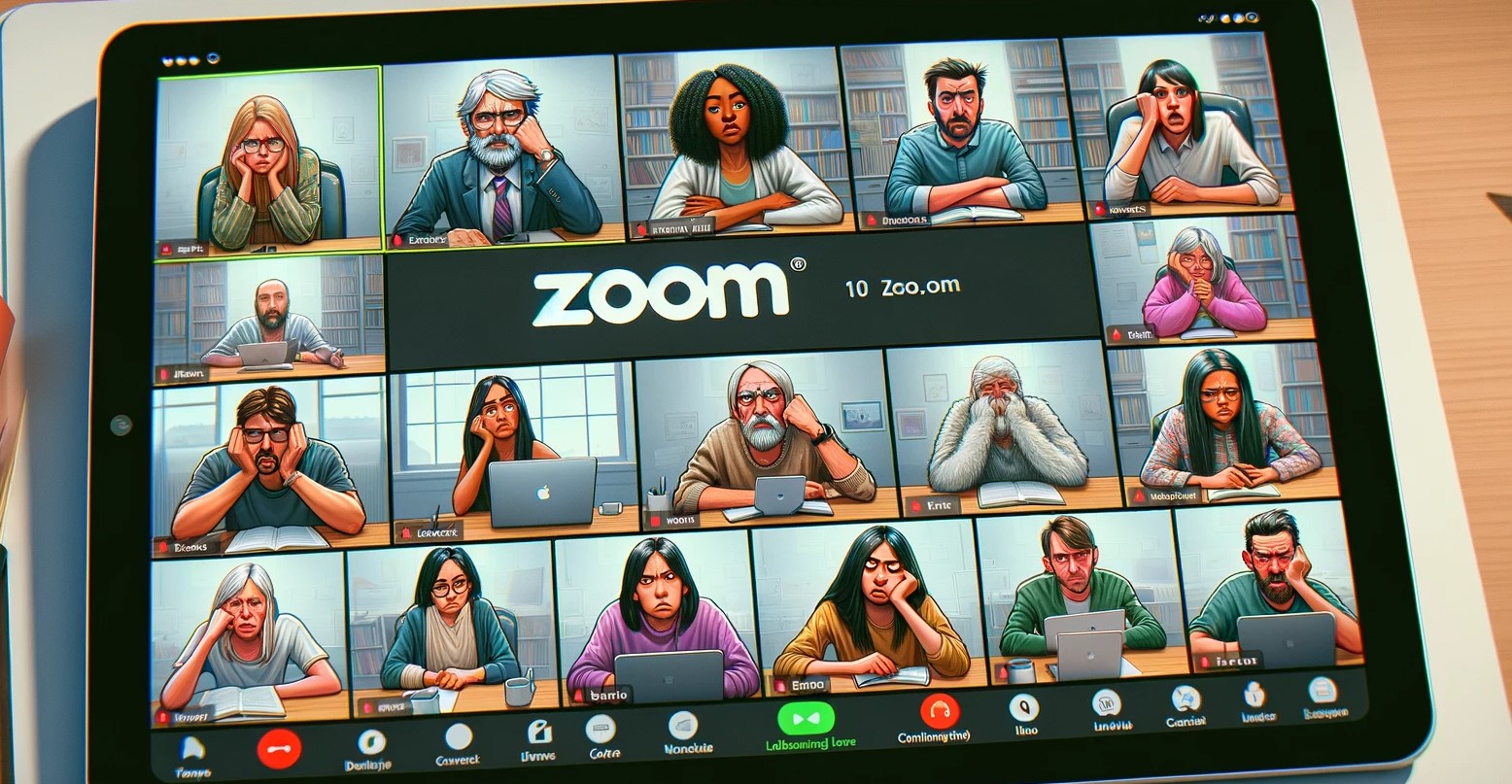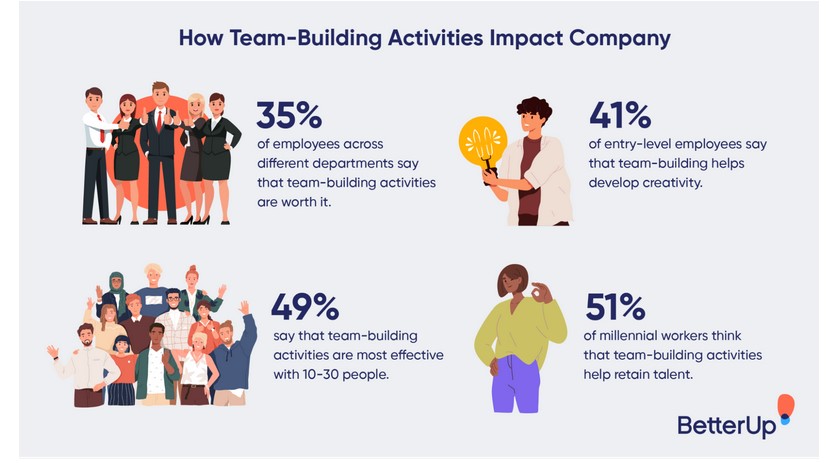As a facilitator and journalist, I’ve watched the business landscape pivot dramatically to virtual spaces, where ‘unity’ is just a click away—or so we’re told.
Yet, there’s a palpable irony that lingers in the air, one that raises eyebrows: why employees hate virtual team building.
Across the board, employees are voicing their concerns, signaling that these digital endeavors may not be the panacea we hoped they would be.
We champion the idea of seamless collaboration and camaraderie in the workforce, but what happens when the screens turn off and the silence sets in?
Virtual team building strives to replicate the vivacity of in-person interaction, creating a vibrant tapestry of connections. However, hurdles present themselves, manifesting as virtual team building disadvantages that can outweigh perceived benefits.
It’s time to dig into the sentiment that’s spreading across cubicles and home offices alike, forming a wall of resistance that even the best video conferencing tools can’t seem to dismantle.
Why Some Employees Hate Virtual Team Building Explained

Key Takeaways
- Dissecting the core reasons behind the aversion to virtual team building.
- Highlighting the contrast between the goals and actual outcomes of digital team efforts.
- Understanding the intricacies of human interaction that virtual spaces fail to capture.
- Focusing on the common grievances that employees share about online team building exercises.
- Identifying the disconnect that can occur in a digital-only team environment.
- Setting the foundation for a thoughtful exploration of virtual team building’s shortcomings.
Unveiling the Resistance to Virtual Team Building
In my exploration of why virtual team building often faces resistance, I have learned that it’s not just about the technology or the activities themselves.
A critical aspect lies within the human element—the employee mindsets.
It’s essential for me to delve into the psychological patterns at play to unravel why the shift to virtual team building is met with hesitation and even discontent.
Understanding Employee Mindsets
Our prior experiences shape how we approach new challenges.
The transition to virtual engagement, while logical from a business continuity perspective, disrupts familiar social dynamics and established workplace norms.
It’s my understanding that employees’ attachment to these established routines can manifest as one of the significant challenges of virtual team building.
Acceptance of a new, digital method demands a mental pivot that not everyone is ready to make.
Looking for fun team building games to boost morale
The Psychology Behind Resistance to Change and Adaptation
Through my research, I’ve determined that the resistance often seen when introducing virtual team building initiatives is deeply rooted in common psychological responses.
It’s a basic human instinct to resist change, especially when it comes without a choice. Our built-in preference for stability and predictability stands in direct opposition to the inherent flexibility and fluidity required by virtual environments.
This is compounded by the myriad of virtual team building problems that can arise, from technology glitches to the lack of spontaneous interaction.
The Lack of Personal Connection in a Digital Space
In my exploration of why virtual team building often falls short of its intended outcomes, a critical factor surfaces: the sheer lack of personal connection in a digital environment.
The engagement and effectiveness of any team building initiative hinge on the ability of the participants to form meaningful relationships.
Traditional, in-person activities inherently offer multisensory interactions—eye contact, body language, and the subtle nuances of voice—that are essential for trust-building.
In the virtual realm, these subtleties are often lost or significantly diluted, impeding the deep relational connections necessary for robust team cohesion.
My examination of this phenomenon leads me to consider the notable differences in the way virtual spaces handle interactions. For instance, a delay in video conferencing can interrupt the natural flow of conversation, making it harder to establish rapport.
The layer of technology can create a barrier that, despite advancements in communication platforms, never fully replicates the immediacy and warmth of face-to-face contact.
As a result, the virtual team building effectiveness is frequently questioned by skeptics who point to these limitations as significant hurdles to genuine engagement.
True connection forms the bedrock of collaborative success; without it, even the most well-intentioned virtual team building endeavors risk falling flat.
Moreover, I’ve witnessed firsthand how a virtual setting can exacerbate feelings of isolation. The absence of a shared physical space means that the casual, impromptu conversations that organically foster camaraderie in an office are rare.
This can lead to a virtual team building engagement paradox, where more frequent digital meetings can somehow result in participants feeling less connected than they would in a less structured, organic setting.
In addressing these issues, it’s important to recognize that while virtual environments present unique challenges, they are not insurmountable.
Strategies to enhance personal connections online include:
- Encouraging the use of video to facilitate visual cues and foster a sense of presence
- Implementing virtual icebreakers that are carefully crafted to break down digital barriers
- Designing activities that require collaboration and mimic the dynamics of in-person teamwork
- Making space for informal virtual gatherings where team members can interact freely
These strategies represent hopeful pathways toward improving virtual team building effectiveness and engagement.
As we continue to navigate the complexities of remote collaboration, it’s imperative we remain vigilant in our efforts to humanize the digital experience and bring authentic connection to the forefront of virtual team dynamics.
Got Games? PRESS PLAY! #boostmorale
Team Leaders! Book a live game show experience today!
Contact us for further details.
We come to your office, venue or off-site location..
For Immediate assistance by text – 917-670-4689
No deposit required. 5-star rated on google.
Why Employees Hate Virtual Team Building: A Deep Dive
Investigating the sentiments surrounding virtual team building, it becomes evident that a disconnect exists between intended outcomes and felt experiences.
This rift primarily stems from the absence of a critical component—the human element. Additionally, such activities have far-reaching implications on the dynamics of workplace culture.
1 – Missing the Human Element
Virtual team building activities are often praised for their convenience and ability to bridge distances, yet I have observed that they frequently fail to replicate the warmth of in-person interactions.
Even the most well-designed virtual exercises cannot fully emulate the spontaneous conversations and body language cues that are vital for fostering genuine connections.
The impact of this missing human element is significant; it can lead to feelings of isolation and disengagement among team members.
2 – The Impact on Workplace Culture
Workplace culture thrives on nuanced, interpersonal relationships—something that virtual environments struggle to cultivate.
As I delve into the topic, the data reflects that virtual team building can introduce a sense of rigidity, often leading to a superficial understanding of co-workers.
This raises questions about how employees integrate virtual interactions into their perception of the overarching work culture and whether these stimulate synergy or inadvertently create partitions.
There is no denying the accessibility and innovative nature of virtual team building activities, but these advantages are sometimes overshadowed by their drawbacks.
To understand why employees might be averse to them, it is imperative to recognize and address the issues surrounding the lack of human touch and the consequent cultural disruptions.
Virtual Team Building’s Impact on Communication
In my exploration of virtual team building challenges, it becomes evident that communication is a multifaceted issue in the remote work environment.
While virtual team building is designed to bring employees together, it often introduces unique obstacles that can hinder clear communication.
Below, I assess the nature of these challenges and offer virtual team building solutions to enhance dialogue and understanding within remote teams.
Understanding each other is the cornerstone of an effective team, but virtual environments can distort the subtleties of human communication. It’s essential to navigate these waters with care to maintain team cohesion.
As we deconstruct the layers of communication within remote teams, it’s clear that virtual settings can significantly alter usual interaction patterns.
Let’s dissect this further into a table that outlines common communication challenges and their potential solutions:
| Virtual Communication Challenge | Potential Solution |
|---|---|
| Lack of Non-Verbal Cues | Implement video conferencing to incorporate visual feedback |
| Time Zone Differences | Use asynchronous communication tools and schedule regular sync-ups |
| Overreliance on Written Communication | Encourage voice or video messages to convey tone |
| Technology Hurdles | Provide training and troubleshooting support for collaboration software |
| Isolation and Misinterpretation | Establish clear communication protocols and check-in regularly |
Addressing the complex tapestry of virtual team building challenges calls for an intricate approach.
For example, integrating video conferencing can offset the lack of non-verbal cues—a significant barrier to understanding in text-based conversations.
Furthermore, by embracing versatile communication tools, we can craft solutions tailored to each unique group dynamic.
As teams become more global, tackling time zone differences is also crucial. Establishing an effective rhythm through asynchronous communication platforms can ensure that everyone stays informed and connected, no matter their location.
By strategically implementing tailored virtual team building solutions, we can nurture an environment conducive to effective, gratifying, and productive teamwork, regardless of physical distance.
Looking for fun team building games to boost morale
Exploring the Effectiveness of Virtual Team Building Activities
In my exploration of virtual team building, I’ve come to understand that effectiveness stretches far beyond the initial completion of tasks.
It’s found in the nuanced details of participant responses, overall engagement, and the subsequent impact on productivity.
Tackling virtual team building problems and fostering engagement are therefore pivotal to constructing a favorable outcome.
a. Case Studies: Virtual vs. In-Person Outcomes
My investigation involved scrutinizing various case studies that chronicled both virtual and in-person team building experiences.
One consistent observation was how virtual team building engagement often hinged on the nature and execution of the activities.
It became evident that merely replicating in-person activities online without adaptation often led to suboptimal participation and low team morale.
b. Measuring Engagement and Productivity
Quantifying engagement and productivity in a virtual setting can be complex. To address this, I implemented a mixed-method approach, combining tangible performance metrics with qualitative feedback surveys.
Such tools helped measure interactive participation levels and the perceived value of virtual team building exercises among employees.
Moreover, I looked at direct correlations between team building exercises and productivity indicators, such as project delivery times and the quality of collaborative output.
I’ve learned that the challenges of virtual team building are often rooted in understanding the culture of remote interaction and the technologies that enable or hamper it.
This awareness has been integral to tailoring activities that directly address these problems, leading to heightened engagement and, ultimately, a more productive virtual workforce.
The Disadvantages of Virtual Team Building
In exploring the landscape of remote collaboration, we often extol the virtues of virtual team building, yet it’s equally critical to address its shortcomings.
Insight into the virtual team building disadvantages not only reveals the areas where this approach can detract from the virtual team building effectiveness but also underscores the facets that may contribute to employee dissatisfaction.
As we evaluate these disadvantages, it’s clear that they often stem from fundamental differences in how remote interactions manifest compared to in-person engagements.
One notable disadvantage of virtual team building lies in the realm of communication nuances.
As we’ve shifted to remote work, the absence of non-verbal cues and spontaneous interactions that naturally occur in a shared physical space can lead to misunderstandings and a feeling of disconnection among team members.
Also, the pervasive issue of “Zoom fatigue” has risen as a psychological toll on employees, tied directly to the extensive use of video conferencing platforms that virtual team building often relies upon.
- Lack of non-verbal cues leading to misinterpretation
- Increased likelihood of “Zoom fatigue” and overreliance on video conferencing
- Potential for unequal participation among team members
- Team building activities may feel contrived or less spontaneous online
- Challenges in fostering a sense of camaraderie and shared purpose
Apart from the psychological and communicative challenges, there are also logistical hurdles that bear mention.
These disadvantages are related to disparate time zones, which can hinder the synchronicity of collaboration, and technical issues that may stifle the fluidity of virtual team building exercises.
This evolving dynamic raises questions about our ability to maintain team cohesion in a digital workspace and the effectiveness of these activities in truly bringing teams together.
By thoroughly examining these challenges, we grasp a holistic view of the virtual team building landscape.
While recognizing its potential, we must remain vigilant about these pitfalls to ensure that our strategies align with our objectives—and most importantly, meet the needs of our team members who navigate these environments daily.
Technical Challenges with Virtual Team Building
The advent of remote working has brought the challenges of virtual team building to the forefront, with technical difficulties often leading the charge against fluid and effective collaboration.
As I delve deeper into these issues, it’s vital to identify and understand the problems that my coworkers and I frequently encounter, from the technology we use to the ways we connect.
Let’s navigate the complexities that these challenges present for virtual teams striving to build and maintain strong working relationships.
a. Navigating Connectivity Issues
Connectivity issues stand as one of the most persistent problems in virtual team building.
Having experienced this first-hand, it becomes clear that the strength and stability of internet connections are not uniform across locations.
When my colleagues experience lag or disconnections during team activities, it not only disrupts the flow of communication but also affects their capacity to contribute meaningfully.
Such disruptions can lead to frustration and a sense of isolation. Addressing these issues involves not only technical support but also a level of patience and understanding that must be fostered within the team.
b. Technology as a Barrier to Inclusivity
While technology promises seamless integration, it can sometimes be the hurdle that complicates inclusion in a virtual setting.
Diverse tech literacy levels among team members mean that not everyone is equally equipped for the digital dive into virtual team building activities.
This reality creates pockets of exclusion and can unintentionally underscore virtual team building problems when various members are left behind due to technical difficulties or unfamiliarity with new software.
Below is a table encompassing common technical challenges that often arise, along with potential approaches to addressing these virtual team building problems that I’ve found effective:
| Technical Challenge | Description | Potential Solution |
|---|---|---|
| Inconsistent Internet Connectivity | Varied internet speeds and stability affecting virtual participation. | Implementing asynchronous collaboration practices to accommodate various time zones and connectivity levels. |
| Technology Fluency | The varying levels of comfort and proficiency with digital tools among team members. | Offering training sessions to build competence and confidence in using collaborative platforms. |
| Hardware Limitations | Lack of access to or familiarity with adequate hardware required for virtual activities. | Standardizing the hardware requirements and providing necessary tools to team members. |
| Software Compatibility | Issues arising from incompatible software across different devices used by team members. | Choosing platform-agnostic tools that ensure smooth operation across various devices and operating systems. |
In my professional journey, I’ve learned that being proactive in recognizing and addressing the technical challenges of virtual team building is essential.
It’s all about fostering an environment where technology serves as a bridge rather than a barrier, thus paving the way for more inclusive and productive virtual collaborations.
Looking for fun team building games to boost morale
Virtual Team Building Solutions: Bridging the Gap
To confront the challenges that come with virtual collaborations, I’ve uncovered virtual team building solutions that target the very core of engagement.
These solutions are not just ideas, but practical ways to bring remote teams together, ensuring that each member feels an integral part of the cohesive whole.
a. Creating Engaging and Inclusive Activities
It’s essential to focus on well-crafted activities that cater to diverse interests and strengths within the team.
This could mean integrating a variety of challenges in team building, from strategic games to creative contests, guaranteeing that every member can participate and contribute.
Furthermore, virtual rooms that simulate breakout sessions can help in personalizing interactions and encourage collaboration on a more intimate level.
b. Fostering Connections Through Technology
Leveraging cutting-edge technology not only enhances participation but also aids in sustaining those hard-to-maintain connections.
Specific software, like virtual whiteboards and project management tools, not only improve workflow but also mimic the sense of shared space, allowing teams to collectively visualize their progress and brainstorm effectively.
Also, apps that support recognition and rewards can significantly improve morale and sustain a shared sense of purpose.
- Interactive online workshops that target skill development
- Regular virtual coffee breaks or happy hours for informal bonding
- Competitive challenges that track progress and celebrate wins
- Virtual team volunteering initiatives for a shared sense of social responsibility
Strategically implementing these virtual team building solutions, can see a palpable shift in engagement and a closing of the gap that distance may initially impose.
For us, the ultimate goal is to facilitate a thriving virtual environment where innovation, camaraderie, and shared success are the standards, not the exceptions.
How Virtual Team Building Engagement Can Be Improved
In seeking to elevate the efficacy of virtual team building activities, we must identify approaches that accentuate engagement and bolster the overall success of these initiatives.
To begin, it is imperative that we address the crux of the issue: engagement. By tailoring virtual team building to individual and group preferences, we make it far more likely that participants will engage meaningfully with the exercises.
This alignment with employee interests and company culture is a foundational component of crafting resonating and effective virtual experiences.
Moreover, to spark a genuine interest and sense of commitment among remote teams, I propose incorporating real-time feedback mechanisms into virtual team building activities.
These interactive elements can serve not only to assess the immediate effectiveness of the activity but also to foster a sense of agency and voice among employees.
This approach underscores the fact that virtual team building engagement stems not only from participation but also from a reciprocal listen-and-adapt strategy.
Lastly, reassessing and refining these virtual initiatives is as crucial as their initial implementation.
Establishing metrics for virtual team building effectiveness allows us to measure outcomes against objectives and iterate accordingly.
By tailoring future activities using data-driven insights, organizations can ensure that virtual team building is not just a check-box exercise but a dynamic, integrated element of team development.
My expectation is that by embracing innovation and feedback, we can surmount the indifference that often accompanies virtual team building and foster a culture of connectedness and collaboration.

FAQ – Disliking Virtual Team Building
Why do some employees dislike virtual team building?
Employees often dislike virtual team building because they feel it can lack personal interaction and connection, which are more naturally fostered in face-to-face settings.
The virtual environment can sometimes feel forced and fail to replicate the camaraderie and engagement of in-person experiences.
What are the disadvantages of virtual team building?
Disadvantages include the potential for technical issues, a feeling of detachment due to the absence of physical presence, and the difficulty in capturing and maintaining participants’ attention.
Additionally, it often requires more effort to encourage genuine engagement and enthusiasm virtually.
How can the digital space impact the effectiveness of virtual team building activities?
The digital space can hinder the spontaneity and organic interactions that occur in person, potentially making it harder to build trust and rapport.
This lack of personal connection might make some employees question the effectiveness of the activities and their ability to enhance team dynamics.
How does virtual team building affect workplace culture?
Virtual team building can sometimes disrupt the natural development of workplace culture by imposing structured interactions that may feel less authentic.
It can also make it challenging for team members to informally connect and develop the shared experiences that contribute to a vibrant workplace culture.
What are common communication challenges in virtual team building?
Communication challenges include issues with clarity, misunderstandings due to lack of non-verbal cues, and the possibility of technical glitches disrupting conversations.
Moreover, the feeling of being on camera can make some individuals self-conscious, thereby affecting their communication style.
What technical challenges do virtual teams often face?
Teams can encounter issues such as unreliable internet connections, software compatibility problems, difficulty managing virtual collaboration tools, and varying levels of technological literacy among participants.
All of these challenges can impact the smooth running of team-building exercises.
How can virtual team building be made more engaging and inclusive?
By creating activities that are tailored to the team’s interests, promoting interactive and collaborative tasks, using technology that is accessible to all team members.
Also, ensuring clear communication, and offering various ways to participate, virtual team building can become more engaging and inclusive.
Got Games? PRESS PLAY! #boostmorale
Team Leaders! Book a live game show experience today!
Contact us for further details.
We come to your office, venue or off-site location..
For Immediate assistance by text – 917-670-4689
No deposit required. 5-star rated on google.









